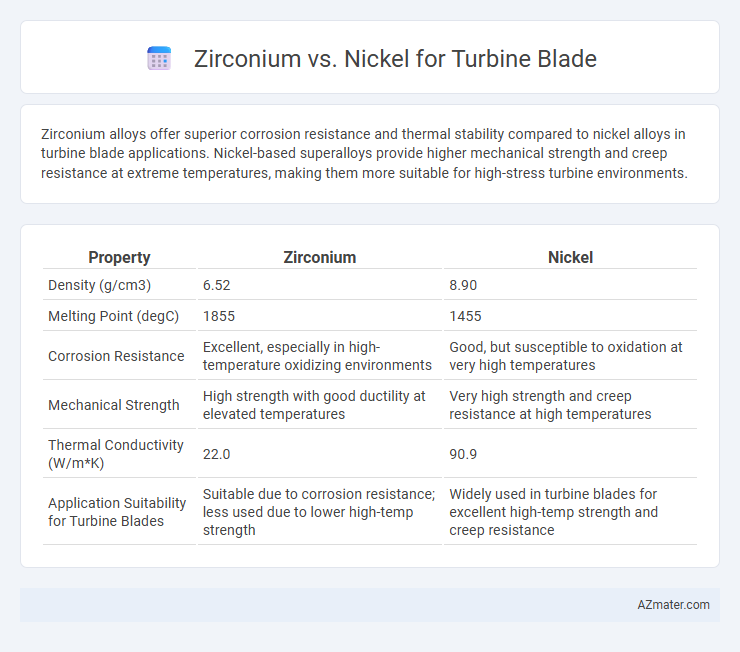Zirconium alloys offer superior corrosion resistance and thermal stability compared to nickel alloys in turbine blade applications. Nickel-based superalloys provide higher mechanical strength and creep resistance at extreme temperatures, making them more suitable for high-stress turbine environments.
Table of Comparison
| Property | Zirconium | Nickel |
|---|---|---|
| Density (g/cm3) | 6.52 | 8.90 |
| Melting Point (degC) | 1855 | 1455 |
| Corrosion Resistance | Excellent, especially in high-temperature oxidizing environments | Good, but susceptible to oxidation at very high temperatures |
| Mechanical Strength | High strength with good ductility at elevated temperatures | Very high strength and creep resistance at high temperatures |
| Thermal Conductivity (W/m*K) | 22.0 | 90.9 |
| Application Suitability for Turbine Blades | Suitable due to corrosion resistance; less used due to lower high-temp strength | Widely used in turbine blades for excellent high-temp strength and creep resistance |
Introduction to Turbine Blade Materials
Turbine blade materials must exhibit exceptional high-temperature strength, corrosion resistance, and fatigue durability to withstand extreme operational conditions. Zirconium alloys offer superior oxidation resistance and corrosion resistance in high-temperature environments but have lower mechanical strength compared to nickel-based superalloys. Nickel alloys dominate turbine blade applications due to their outstanding creep resistance, thermal stability, and ability to maintain integrity under prolonged mechanical stress at temperatures exceeding 1000degC.
Overview of Zirconium and Nickel
Zirconium exhibits exceptional corrosion resistance, high melting point, and good mechanical strength, making it suitable for high-temperature turbine blade applications. Nickel, known for its excellent heat resistance, oxidation resistance, and superior creep strength, is commonly used in superalloys for turbine blades operating under extreme thermal and mechanical stress. Both metals play crucial roles in turbine blade manufacturing, with nickel-based superalloys dominating due to their outstanding performance in high-temperature efficiency and durability.
Mechanical Properties Comparison
Zirconium exhibits superior corrosion resistance and good creep strength at high temperatures, making it suitable for turbine blade environments exposed to aggressive gases. Nickel alloys, particularly Inconel, provide higher tensile strength and excellent fatigue resistance, ensuring durability under cyclic thermal and mechanical stresses. While nickel offers better overall mechanical robustness, zirconium is preferred in applications requiring enhanced oxidation resistance and lower density for weight-sensitive turbine components.
Corrosion and Oxidation Resistance
Zirconium exhibits superior corrosion resistance in high-temperature and aggressive oxidative environments compared to nickel, making it highly effective for turbine blade applications where oxidation resistance is critical. Nickel-based alloys also provide excellent oxidation resistance but tend to form protective oxide layers that may degrade under extreme thermal cycling conditions. Zirconium's ability to maintain structural integrity and resist hot corrosion enhances turbine blade longevity and performance in harsh operational settings.
High-Temperature Performance
Zirconium alloys exhibit superior high-temperature strength and oxidation resistance compared to nickel-based superalloys, making them advantageous for turbine blade applications in extreme thermal environments. Nickel alloys maintain excellent creep resistance and phase stability at elevated temperatures around 1000degC, essential for maintaining blade integrity under stress. The choice between zirconium and nickel hinges on the specific thermal cycles and mechanical demands, with zirconium favored in oxidative conditions and nickel preferred for mechanical endurance at ultra-high temperatures.
Fabrication and Machinability
Zirconium offers excellent corrosion resistance and high-temperature stability, making it suitable for turbine blade fabrication, but its machining requires specialized tools due to poor thermal conductivity and tendency to gall. Nickel alloys, particularly Inconel, provide superior mechanical strength and oxidation resistance at elevated temperatures, and exhibit better machinability with standard cutting tools, enabling efficient manufacturing processes. The choice between zirconium and nickel hinges on balancing fabrication complexity against performance demands in turbine blade applications.
Cost and Material Availability
Zirconium offers superior corrosion resistance and high-temperature stability for turbine blades but is significantly more expensive and less abundant than nickel. Nickel alloys, widely used in turbine blades, provide a cost-effective balance of strength, thermal resistance, and material availability due to extensive mining and production infrastructure. The choice between zirconium and nickel hinges on budget constraints and supply chain reliability, with nickel remaining the preferred option for mass production.
Applications in Aerospace and Power Generation
Zirconium alloys offer excellent corrosion resistance and high-temperature stability, making them suitable for turbine blades in aerospace engines where durability under extreme thermal stress is critical. Nickel-based superalloys dominate power generation turbine blades due to their superior creep resistance, strength at elevated temperatures, and ability to maintain mechanical integrity in harsh environments. In aerospace, zirconium's lower density contributes to weight reduction, whereas nickel's robustness is preferred in power plants for long-term operational efficiency under continuous high-temperature conditions.
Environmental Impact and Safety
Zirconium alloys exhibit superior corrosion resistance and lower environmental toxicity compared to nickel-based superalloys commonly used in turbine blades, reducing the release of harmful metal ions during operation and disposal. Nickel alloys, while offering excellent high-temperature strength, pose greater environmental risks due to nickel's potential for bioaccumulation and allergenic effects, necessitating careful handling and recycling protocols. The safety profile of zirconium in turbine applications also benefits from its lower oxidation rates and reduced risk of toxic oxide formation under extreme temperatures, enhancing both operational safety and environmental sustainability.
Summary: Choosing Between Zirconium and Nickel
Zirconium offers superior corrosion resistance and thermal stability, making it ideal for turbine blades operating in oxidizing or high-temperature environments. Nickel-based alloys provide exceptional strength and creep resistance under extreme mechanical stress and temperatures typical of turbine operations. Selecting between zirconium and nickel depends on balancing corrosion resistance with mechanical durability requirements specific to the turbine blade's operating conditions.

Infographic: Zirconium vs Nickel for Turbine blade
 azmater.com
azmater.com